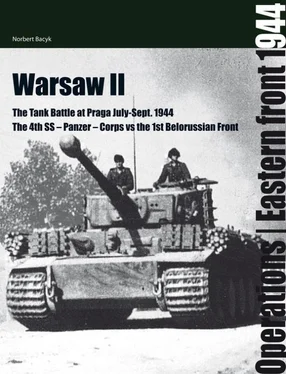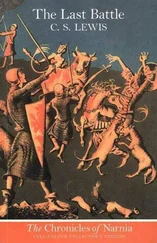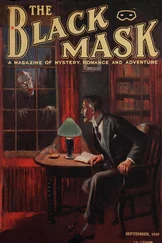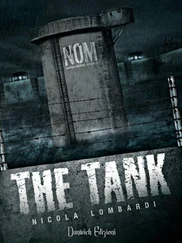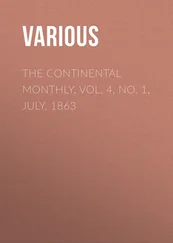Zjukov and the other officers at headquarters had another plan. For them, it was the bridge emplacements that were vital. After the success in the Balkans, it was around these strategic locations that they wanted to assemble the main Soviet combat strength and focus on a decisive offensive against Berlin. This concept originated in the summer of 1944 and became a reality by the winter of 1945. As it turned out, Warsaw played a subordinate role in the Soviet military plans. Gaining control of the city’s Praga sector was viewed as a high priority objective that should be accomplished as soon as possible, which is to say, during the first week of August. It was quite obvious that the chances of gaining control over the bridge emplacements were nearly non-existent. The Germans had mined them, and the approach roads to the bridges were covered by 88 mm guns and machine-guns hidden in concrete bunkers. The Soviets had gotten this intelligence toward the end of July from its agents and air-reconnaissance. Storming city sectors west of the river with frontline troops using Praga as a jump-off location was completely dismissed for tactical reasons. All of those cities built around rivers, like Kiev and Budapest, were seized through outflanking manoeuvres this also proved to be the case at Warsaw when it finally fell in January of 1945. Zjukov intimated to Rokossovskij that the city would be captured from the bridge abutments south of the Polish capital. In which case, the 8th Guards Army would be able to carry it out.

Katyusha BM 13-16 launching rockets against the Germans in July 1944 in Eastern Poland. (Leandoer & Ekholm Archive)
The political question remained however, and it presented a particularly sticky problem. Stalin was concerned about the Home Army’s troops in Warsaw, not from a military perspective but for propaganda reasons. Any attempt to disarm the Polish resistance movement in the capital city naturally threatened to awaken violent conflict to life. It appears — with respect to this matter, no documentation has been saved — as if the Soviet dictator awaited the outcome of the assault and was counting on a rapid seizure of Warsaw. The radio station “Kościuszko” which was controlled by the communists, encouraged the Uprising. This kind of appeal was standard Soviet operating procedure when a need was seen to dilute the ferment of concern in the resistance movement’s backers. Fighting in the city would work to facilitate Soviet troop operations. In Warsaw, not only had the home-army remained combat ready, along with the organizations that co-operated with it, but also the so-called “People’s-Army.” Much depended on the precise time point the Uprising took place.
Stalin must have known, with a fair degree of certainty, that the 2nd Tank Army which was due to attack Praga with only one tank corps (the other two were designated to cut off the German 2nd Army) would not be strong enough to seize Warsaw‘s central sectors west of the river. The regular infantry armies could carry this out. But these forces wouldn’t arrive at the city until a couple of days later, and unless there was a state of total chaos on the German side or an uprising, nothing could guarantee a successful crossing of the Wisła in an urban setting. What the Soviet dictator actually planned, we’ll never know. Perhaps he had counted on the fighting breaking out in the city prematurely. His perception was that the Germans would pacify the city within a couple of days and destroy the Home Army, after which the 8th Guards Army could enter the Polish capital from the south. It’s also possible, as has already been mentioned, that Stalin shelved decisions concerning Warsaw until later and, in effect, let them be decided based on what resulted from the frontline attacks east of Poland’s capital.
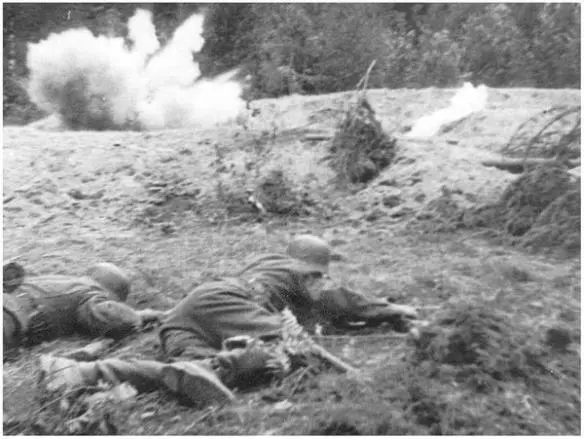
German infantry under fire outside of Warsaw in July 1944. (Leandoer & Ekholm Archive)
Towards the end of July, military operations began to directly take in Praga’s south-eastern suburbs. On July 27, brigades with frontline troops from the 2nd Tank Army began a series of debilitating battles over a 40km stretch and took possession of the Garowlin-area. At that moment, the German 9th Army’s command of the approaches into Warsaw rested solely on General Fritz Frank’s 73rd Infantry-Division (the 70th, 170th and 186th Infantry-Regiments, and Artillery-Regiment 173) along with smaller units drawn from General Wilhem Schmalz’s division “Herman Göring” (Aufklärungs-Abteilung and a portion of Flak-Regiment). General von Vormann deployed, rashly enough, these weakened forces (Gruppe “Frank”) to the south with the mission of impeding the pace of the Soviet advance. In fighting with two Soviet tank corps over July 27-28, the 73rd Infantry-Division suffered heavy losses and was driven back to the Otwock — Minsk Mazowiecki line. General Frank was taken prisoner and a portion of the units from his division escaped in tatters to the other side of the Wisła.
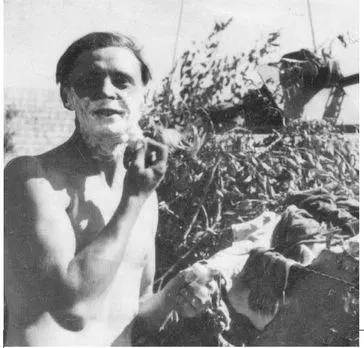
“If only there was time…”
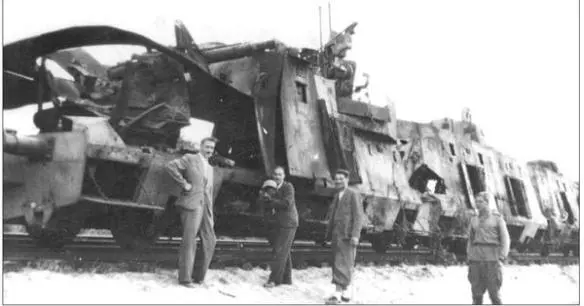
The destroyed German armoured train no. 74, in the Otwock-region, July 1944

A mounted reconnaissance patrol from an infantry unit, one early morning outside Warsaw, July 1944.
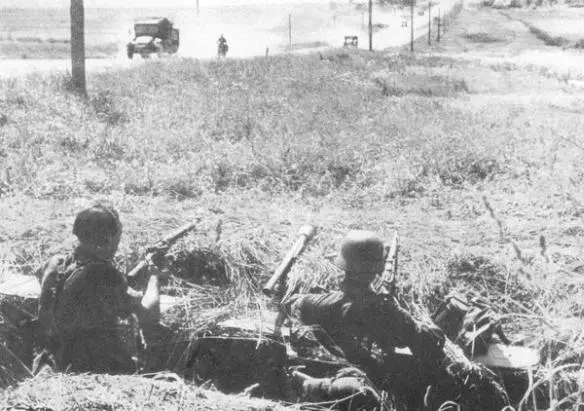
Forward at the frontline! German fixed positions at the furthermost point along the frontline. Retreating units race by the two entrenched soldiers in July 1944 outside Warsaw. Note the Panzerfaust!
(All pictures: Leandoer & Ekholm archive)
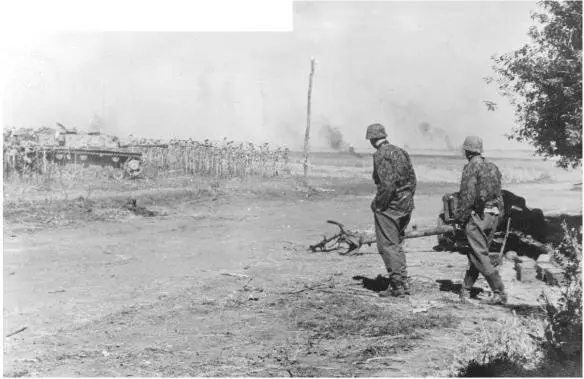
An assault-gun StuG 40 Sd Kfz 142/1 Ausf. G and an anti-tank 5 cm Pak 38 from a Waffen-SS unit lying in ambush on the eastern front, summer 1944. (CAW)
In this situation, the status of the 9th Army became critical. On July 27, Hitler appointed General Reiner Stahel as commander of the entire Warsaw military district. He was regarded as an expert in urban warfare. Actually, Stahel was an officer in the Luftwaffe, but had already been posted as commandant over Rome and Vilnius in 1944. Hitler ordered Stahel to defend the city “at any price.” The Germans knew about the plans for an uprising and therefore prepared their troops for fighting on two fronts. The troop strength at the city’s outposts was reinforced and soldiers from Pionier-Bataillon 654 awaited orders to blow up the bridges. Model wanted to stop the 2nd Tank Army with a sudden counter-attack east of the Praga district, and at the same time, protect Warsaw with division “Herman Göring “ and the 73rd Infantry-Division. He also got the all-clear to redeploy 19th Tank-Division from the north to the Warsaw region and placed it on combat-ready status.
On the other side of the front, General Radzjijevskij’s two tank corps approached Praga on July 28. The third, the 16th Tank Corps, remained a little in the background, but quickly tried to link up with the rest of the army by attacking directly along the Wisła’s eastern shore — behind them, trailed rifle divisions from the 8th Guards Army. General Vasilij Tjujkov received orders to cross the river south of the capital (the order was formally issued on July 29, 1944). At the same time, in the area around Kazimierz Dolny, the 69th Army had already begun to cross the river and the 1st Polish Volunteer Army stood outside Dęblin. At Siedlce, the rapid response force and the 47th Army, which had just arrived in the area, were engaged in heavy fighting. After taking Brest, the 70th Army relentlessly drove a fortification garrison westwards, while the 61st Army had just begun to withdraw from the 1st Belorussian Front.
Читать дальше
